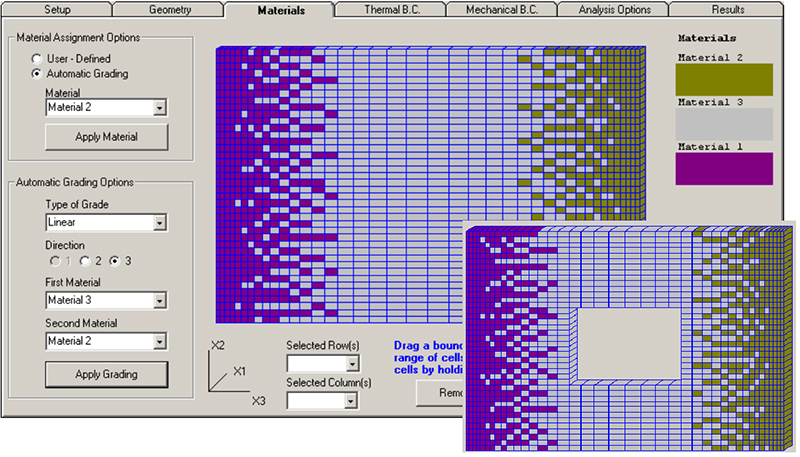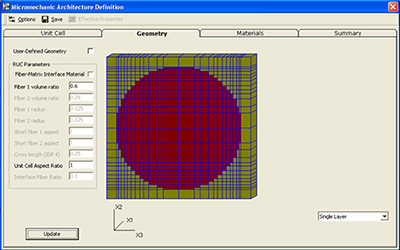
Efficient, Multi-Scale Designs Take Flight
Engineers can solve aerospace design problems faster and more efficiently with a versatile software product that performs automated structural analysis and sizing optimization. Collier Research Corporation's HyperSizer® Structural Sizing Software is a design, analysis, and documentation tool that increases productivity and standardization for a design team. Based on established aerospace structural methods for strength, stability, and stiffness, HyperSizer can be used all the way from the conceptual design to in-service support.
The software originated from NASA's efforts to automate its capability to perform aircraft strength analyses, structural sizing, and weight prediction and reduction. With a strategy to combine finite element analysis with an automated design procedure, NASA's Langley Research Center led the development of a software code known as ST-SIZE from 1988 to 1995. Collier Research employees were principal developers of the code along with Langley researchers. The code evolved into one that could analyze the strength and stability of stiffened panels constructed of any material, including light-weight, fiber-reinforced composites.
After obtaining an exclusive NASA license for ST-SIZE in 1996, Hampton, Virginia-based Collier Research combined the code with other company proprietary software, taking it from the research level to the commercial level with full documentation, training, and quick response support. Marketed as HyperSizer, the software couples with commercial finite element analyses to enable system level performance assessments and weight predictions; conceptual and preliminary design optimization of material selection/layup and structural member sizing; and structural failure analysis and automated stress reports.
Continuing to advance HyperSizer by expanding its capabilities and features, Collier Research began working with NASA's Glenn Research Center in 2001. The goal, initiated through several NASA contracts and grants, was to integrate and commercialize the Micromechanics Analysis Code with Generalized Method Cells (MAC/GMC) and the higher-order theory for functionally graded materials (HOTFGM). Both MAC/GMC and HOTFGM were developed collaboratively with personnel at Glenn, the University of Virginia, the Ohio Aerospace Institute, and Israel's Tel-Aviv University.
MAC/GMC is a well-documented software package for the design and analysis of advanced composite materials that accurately predicts the elastic and inelastic thermomechanical response of multiphased materials including polymer-, ceramic-, and metal-matrixcomposites. The software enables engineers and material scientists to design and analyze composite materials for a given application accurately and easily. The well-established generalized method of cells micromechanics theory provides the underlying analysis technology for MAC/GMC.
The HOTFGM theory and code are designed to model the thermal and mechanical response of structures with arbitrary cross-sections composed of functionally graded materials. These new technologies enable the HyperSizer analysis to localize beyond its traditional stiffened panel and laminate ply scale. Equipped with the MAC/GMC and HOTFGM capabilities, HyperSizer can now design on the microscale, considering the individual fiber and matrix phases, their arrangements, and their likelihood to initiate failure of the global aerospace structure.
Through its efforts to commercialize HOTFGM and MAC/GMC, Collier Research now includes Hyper-FGM and Hyper-MAC as part of its product line. Hyper-FGM uses HOTFGM as its underlying analysis technology and is a self-contained software package developed as a tool for the design and analysis of functionally graded materials (FGMs). It includes pre- and post-processing through an intuitive graphical user interface, along with the HOTFGM thermo-mechanical analysis engine.
The Hyper-FGM interface builds on the well-established accuracy of the HOTFGM mechanics methodology, making HOTFGM available as a practical commercial product. After an FGM problem is specified, the HOTFGM-based analysis can be executed from within Hyper-FGM, and the results are automatically loaded into the interface for viewing and post-processing. With its ease of use, Hyper-FGM provides an effective alternative to the more user-intensive approach of modeling FGMs through finite element analysis packages.
Hyper-MAC is an add-on module for the HyperSizer software that combines the constituent buildup (formation of repeating unit cell) and nonlinear analysis of the NASA-developed MAC/GMC with HyperSizer's data integrity, established laminate analysis methodology, and material property editing interface. The inclusion of micromechanics within HyperSizer creates a new distinction between material types: heterogeneous and homogeneous. Homogeneous materials have no underlying micromechanics architecture and are analyzed using only equivalent, or effective, properties. Heterogeneous materials have effective properties that are calculated using a micromechanics model given specified microscale constituent properties and architecture. Consequently, Hyper-MAC enables users to create and use new homogeneous materials based on micromechanics-generated effective properties and to perform virtual experiment simulations to determine the effective response of heterogeneous materials.
While targeted to the aerospace industry, the line of HyperSizer products impacts a variety of additional commercial applications. In the transportation industry, HyperSizer's cost-effective design capability with stiffened wall construction concepts makes it ideal for designing and analyzing rail cars, tractor trailers, dump trucks, and shipping containers. HyperSizer can also be used for new and innovative designs for the marine industry, ranging from scantlings of composite hull panels for high speed light craft to stiffened plate panels of hull girders, side shells, and bottom structures. Since HyperSizer can achieve the lightest weight for any marine design, it benefits high-speed vessels such as passenger catamarans and rescue vehicles that are weight optimized to obtain high speeds.
HyperSizer® is a registered trademark of Collier Research Corporation.

Hyper-MAC, an add-on module for the HyperSizer® software, enables users to create and use new homogeneous materials based on micromechanics-generated effective properties.

Collier Research Corporation’s Hyper-FGM software package is a tool for the design and analysis of functionally graded materials. It includes pre- and post-processing through an intuitive graphical user interface, along with the HOTFGM thermo-mechanical analysis engine.













